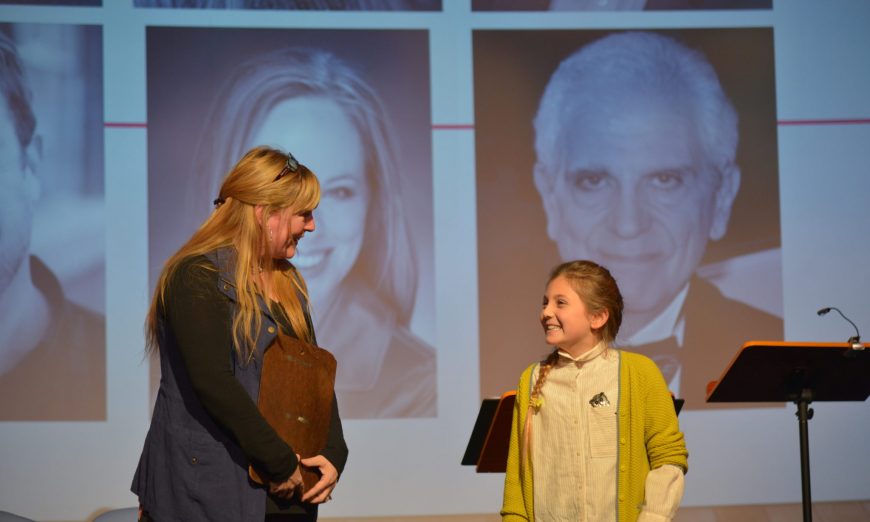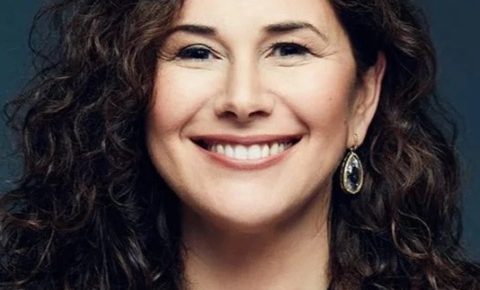A few weeks ago a friend asked about a favorite picture of mine. It’s of my great-great-grandmother Katharina Frega, a widow who came to New York from Lungro, Calabria in 1887 with her three daughters.
That picture is the departure point for many stories for me, both historical and personal.
All pictures are such departure points. That’s the idea of Iris Rainer Dart’s 2011 musical, The People in the Picture. Guggenheim Entertainment is staging a revival of the show—which hasn’t been produced since its original New York run—with new musical numbers and a revamped script and staging to accommodate the intimate 3Below theater in downtown San José.
The show tells a multi-layered story that is both historical and individual. At the individual level it’s a family story set in the 1970s. It’s the story of three generations: Raisel Rabinowitz (Susan Gundunas) a former star of the Yiddish theatre in pre-WWII and wartime Poland, now living in New York: her daughter Red (Julia Wade) who tries to shut out the past; and Raisel’s granddaughter, Jenny (Natalie Schoreder) who opens her heart to it.
A second layer of the story is historical. The “people in this picture” of the title are “The Warsaw Gang,” a troupe of Yiddish theater actors continuing against all odds to create brightness despite the horror of the Nazi occupation, the Warsaw Ghetto Uprising and even in the hells of concentration camps.
Last month, the Guggenheims had a conversation with Dart and some of the actors in the production. Dart spoke about how she came to write The People in the Picture, and the meaning of the show.
“I grew up in a Yiddish-speaking household,” said Dart. “We were poor, but I never thought of myself as being deprived because we always laughed. It was the Yiddish culture—it was so joyous.”
Dart went on to undisputed success as a TV script writer for That Girl, Love American Style and the Cher Show and cemented her success with the novel Beaches, subsequently made into a film. But she never forgot where she came from.
“Memory is a legacy,” Dart said, “passing on what I know to make sure it’s not forgotten.”
Yiddish Theater, once a vibrant part of European and North American culture, was devastated by the Holocaust and is today little-known by the wider culture.
“If you don’t do it,” Dart said, “it ceases to exist.” She was determined to not just preserve, but to expand the awareness of this remarkable cultural treasure.
“One day I discovered a catalog of Yiddish films from pre-War Europe and watched them,” she explained. The films were from the period right before WWII, 1935-1939, and despite the darkness of the coming war, “these composers were making musical comedies. I felt I had to write about a woman who was a Yiddish actress and singer and what does she think about when she’s in the Warsaw ghetto, when she’s in the camps.”
Talent, as the program notes say, is sometimes all artists have left. But it’s a powerful force, as well, as the drama shows.
People in the Picture got its formal start when Bette Midler called Dart and asked her to write a script for a singer. Dart went to work, collaborating with Mike Stoller—composer of the music for Jailhouse Rock—and Artie Butler—song producer and arranger of Copacabana.
The shift between eras is reflected in the music that recalls 1930s popular songs, klezmer music and 1970s soft pop. People in the Picture opened on 2011 on the 75th anniversary of Warsaw Ghetto uprising.
Many may find it difficult to wrap their heads around a musical about the Holocaust—outside The Producers‘ “Springtime for Hitler” farce-within-a-play.
“That’s the tough part of selling a show like this,” said Shannon Guggenheim, who co-directs the show with husband Scott.
“When you tell someone it’s a Holocaust musical they think twice. But we were drawn to this because of the world today,” she explained. It’s incumbent on each generation to show a new generation what came before and how history unfolds, she said. “We see the people in the Warsaw ghetto and they don’t know what’s about to happen to them.”
Raisel’s stories of the people in the picture, told to her granddaughter, take the audience not just back to that dark history, but also to the history of human endurance and the tenacity of hope.
The People in the Picture opens April 12 and runs Thursdays-Sundays through May 13 at 3Below Theaters and Lounge, 288 S. 2nd Street, San José. Thursday-Saturday shows at 7:30 p.m. and Saturday and Sunday shows at 2:30 p.m. Tickets are $41-$58, preview shows are $25. For information, visit www.3belowtheaters.com or call (408) 404-7711.
As part of the performance, there will be a pre-show presentation if audience members sharing the people in their picture. For more information on how to be involved, and be entered to win a family heirloom crafting kit complete with archival paper and embellishments, shadow box and instructions on how to create your heirloom, email info@3belowtheaters.com
You can find more about Yiddish films at YiddishCinema.net, JewishFilm.org, www.myjewishlearning.com and you can also find Yiddish film clips on YouTube.






